The Ultimate Guide to Screen Cage Humidity
Maintaining the correct humidity level in your screen cage is crucial for the health and well-being of your reptile or amphibian. Too much or too little moisture can lead to serious health problems, impacting everything from shedding to respiratory function. This comprehensive guide will walk you through understanding humidity, measuring it accurately, controlling it effectively, and troubleshooting common issues.
What is Humidity and Why is it Important?
Humidity refers to the amount of water vapor present in the air. In a screen cage environment, humidity directly impacts your pet's ability to properly shed their skin, regulate their body temperature, and maintain a healthy respiratory system. Different species have different humidity requirements; some thrive in arid conditions, while others need a consistently humid environment. Understanding your pet's specific needs is paramount.
Measuring Humidity in Your Screen Cage:
Accurate humidity measurement is the first step to effective control. Avoid relying solely on your feelings; invest in a reliable digital hygrometer/thermometer. These devices provide precise readings of both temperature and humidity, crucial data for maintaining an optimal environment. Place the hygrometer inside the cage, at the level where your pet spends most of its time, to get the most accurate reading.
How Often Should I Check Humidity?
Ideally, you should check the humidity in your screen cage at least once a day, especially when first setting up the cage or making significant changes to its environment. More frequent checks might be necessary depending on the species and the effectiveness of your humidity control methods. Regular monitoring ensures you can quickly adjust if necessary and prevent problems before they arise.
What is the Best Type of Hygrometer for a Screen Cage?
Digital hygrometers are generally preferred for their accuracy and ease of use. Look for models specifically designed for reptile or amphibian enclosures. These often feature probes that can be inserted directly into the substrate for a more representative reading of the humidity near your pet. Avoid analog hygrometers, as they are less precise and prone to inaccuracy.
Controlling Humidity in Your Screen Cage:
Controlling humidity in a screen cage, particularly one made of mesh, can be challenging. However, several methods can effectively raise or lower humidity levels:
-
Increasing Humidity:
- Water Dishes: Large, shallow water dishes provide surface area for evaporation, increasing humidity. Consider multiple dishes, especially in larger enclosures.
- Misting: Regularly misting the cage with a spray bottle can significantly increase humidity. Use filtered or dechlorinated water to prevent mineral buildup.
- Humidity Hides: Providing humid hides made of moss, coconut fiber, or other moisture-retaining materials offers localized areas of high humidity for your pet to retreat to when needed.
- Substrate: Certain substrates, such as coconut fiber or cypress mulch, retain moisture better than others, contributing to overall humidity levels. Avoid using substrates that become easily waterlogged.
- Automated Misting Systems: For more precise and hands-off control, consider investing in an automated misting system.
-
Decreasing Humidity:
- Ventilation: Ensure adequate ventilation in your screen cage. Good airflow prevents excessive humidity buildup, which can lead to mold and mildew.
- Dehumidifier (for extreme cases): In extremely humid environments, a small dehumidifier can be used to lower humidity levels. Place it outside the cage to avoid direct exposure to your pet.
- Reducing Water Sources: If humidity is too high, temporarily reduce the number of water dishes or misting frequency.
What are the Signs of Too Much or Too Little Humidity?
- Too High Humidity: Mold and mildew growth, difficulty shedding, lethargy, and respiratory issues in your pet.
- Too Low Humidity: Difficulty shedding (skin sticking), dehydration, and stress in your pet.
What is the Best Substrate for Maintaining Humidity?
The ideal substrate depends on your pet's specific needs. Coconut fiber, cypress mulch, and sphagnum moss are popular choices for their moisture-retention properties. However, ensure the substrate remains well-draining to avoid waterlogging. Always research the specific substrate requirements for your pet's species.
Troubleshooting Common Humidity Problems:
If you're struggling to maintain the correct humidity levels, consider these troubleshooting steps:
- Check your hygrometer: Ensure your hygrometer is functioning correctly and calibrated.
- Assess ventilation: Too much or too little ventilation can significantly impact humidity.
- Evaluate your substrate: The type and amount of substrate can heavily influence humidity.
- Examine water sources: Ensure your water dishes are adequately sized and filled.
- Adjust misting frequency: Experiment with misting more or less frequently to find the optimal balance.
Maintaining the correct humidity in your screen cage is a continuous process requiring regular monitoring and adjustment. By understanding your pet's needs, utilizing appropriate monitoring tools, and employing effective control methods, you can provide a healthy and comfortable environment for your reptile or amphibian. Remember to always prioritize your pet's well-being and consult with a veterinarian or herpetologist if you have any concerns.

